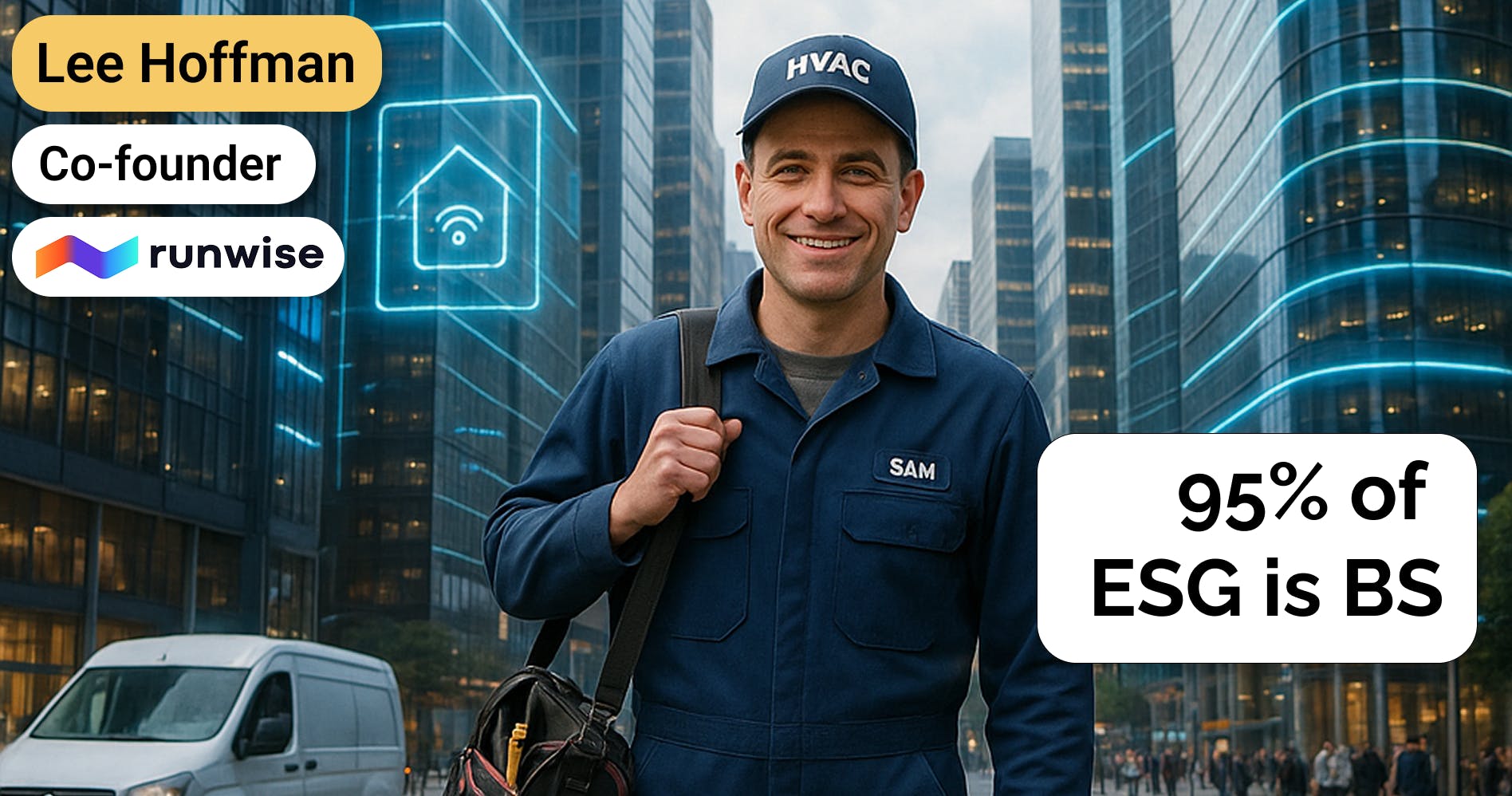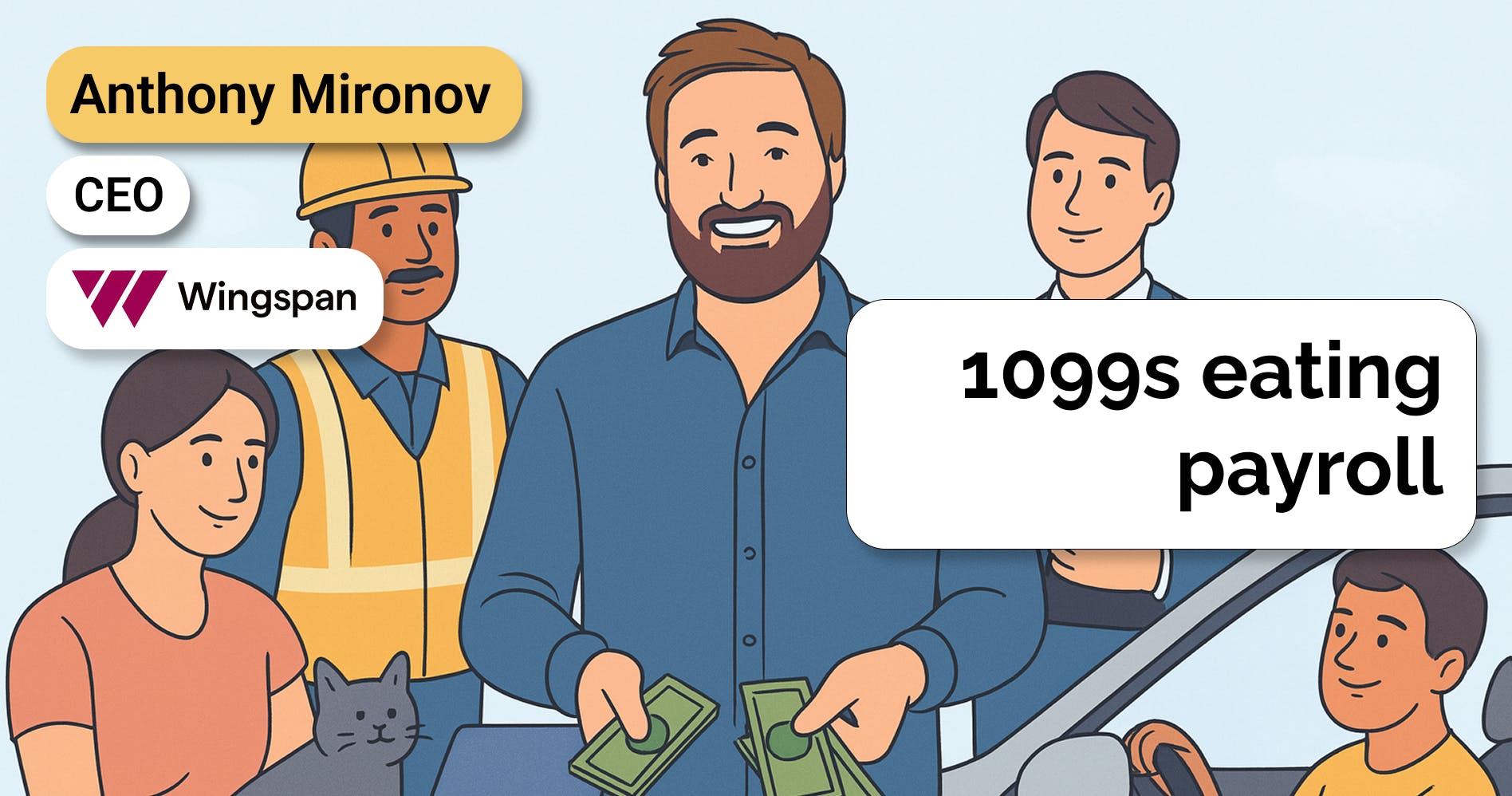Matt Brown, Co-Founder of Bonsai, on the rise of vertical ERPs
 Jan-Erik Asplund
Jan-Erik Asplund

Background
Matt Brown is partner at Matrix Partners and the co-founder of contractor payroll platform Bonsai. We talked to Matt to learn more about the rise of vertical ERPs, where SaaS intersects with finance, and what kinds of vertical businesses are best off building financial services into their apps.
Questions
- Firstly, can you explain the difference between vertical SaaS and vertical ERP. What exactly does that distinction look like?
- What vertical SaaS businesses are best positioned to take the leap into VERP (Vertical ERP)? What makes that shift more likely to succeed?
- Companies can go from a SaaS tool and around the SaaS tool they can accumulate a network and sell financial services into it along with other products. What do you make of the flip where you start with a marketplace and get to the same end state?
- As far as the vision with Bonsai, was the thinking to expand at some point potentially to the company side, and do what Upwork is doing, where once you have connections to both sides, you can become that sort of lead generation business for freelancers and help companies find freelancers via your network? Or is it more to go deeper into the freelance side exclusively?
- One thing we did see is that now if you're building vertical software for contractors, that used to make you unique. Whereas now, there's a lot of vertical SaaS targeted at some of these specific kinds of folks. How do you think about competing within a vertical to win? How do you, as an investor, think about the wedge and how you discern between different companies that way?
- What happens to all the contractor payroll platforms when every vertical SaaS has their own embedded payroll? Does that become a potential replacement for every vertical SaaS just be able to run payroll natively?
- How would you taxonomize the overall space of freelancers and contractors?
- Do you have an opinion or take on where neobanks are now and where they might be going, supplanted by vertical ERPs?
- Could you talk about the different kinds of monetization levers that there are with VERPs?
- Square comes up a lot around SMB, fintech, payroll, and checking. How do you think about them sort of competitively against the span of vertical ERPs? Are they a competitive threat?
Interview
Firstly, can you explain the difference between vertical SaaS and vertical ERP. What exactly does that distinction look like?
Vertical SaaS is a relatively mature category, at least, the idea of the category is relatively mature. It's exactly what it sounds like: It's a software product that's built for a specific type of business or consumer or industry, and generally that software is very opinionated around that industry. It’s monetized through a SaaS model, per seat, or license or a measure like that. It also typically aims to absorb as much of the workflow of that business as possible.
Let's say you're building vertical SaaS for in-person service businesses, you don't want them to use one SaaS tool for scheduling, another SaaS tool for employee management, another SaaS tool for lead generation, and stitching all those together and bringing that all in place. The vertical SaaS solves that, puts all of those tools under one roof, and absorbs the workflow there.
Where vertical ERPs are different is they take advantage of these new embedded financial products—the ability to embed payments, the ability to embed card issuing and banking and bank accounts, deposit accounts, even things like tax prep and tax filing or accounting—and allows companies to absorb cash flow into that, as well. To summarize, vertical SaaS is just absorbing as much workflow as possible, and vertical ERPs are absorbing workflow, as well as the cash flow of the business.
That, to me, has always been a huge missing piece and missed opportunity in these vertical SaaS businesses. They have these theoretical representations of payments coming in and customers and what's the balance on the bank account and how profitable or is this part of the business or not in a given month. You could think of it as having read access to that part of the business, but the really powerful thing about verticalERPs is they actually have right access to the cash part of the business as well.
What vertical SaaS businesses are best positioned to take the leap into VERP (Vertical ERP)? What makes that shift more likely to succeed?
Any case where the cash flow or the flow of funds or payments are complex in some way. There are a couple different things that can mean. Let's take restaurants, for example: You have multiple bills, and typically a successful restaurant has a high volume of payments. You have individual bills per table, then you have tipping, and tipping needs to be allocated with some regulatory formula as well as the rules of the restaurant to the servers and various staff. That's a relatively complex payment flow. Stripe likely isn’t going to build a tip-routing engine any time soon. That's one specific example.
There are other ones where, maybe you're paid on a per job basis, or maybe there's a flat fee for an in-person service business that also makes some kind of revenue share on the products they sell to the homeowner they’re working with, for example. So there's some kind of revenue share. Not only the transfer of funds, but the accounting of that funds flow can be relatively complex.
A great example of this is a business called WeTravel, where they are a vertical SaaS and payments for multi and often international tour operators. This is an example of an incredibly complex funds flow, where you're booking a safari in Africa. Generally, the person who's booking that trip is paying months in advance, sometimes in installments, this company is holding these funds. Often the consumer or customer is paying on a schedule. The tour company then needs to split these funds out to various local users. They need to pay the hotel in this place and they need to pay the driver in this place in cash. This person doesn't accept credit cards, but accepts this local payment method. The disbursement of payments there is very complex and that has a lot of this complexity.
Large volume of payments, international payments, payment ahead of time, disbursement of payments in foreign currency payment methods—that alone is an incredibly complex business or set of funds flows that you need to manage. Not to mention again, the vertical SaaS associated with that business, which includes a marketing website and booking. Maybe there's some concept of lead nurturing, some concept of e-signing that you need to do for these folks. I think that's another example where it's not as simple as just moving payments.
As you have these embedded fintech rules making the building block payments easier, different kinds of payments—not just credit card, but international payments and currency conversions and cash disbursement and things like that—smart entrepreneurs who know these industries very, very well, their ears are going to prick up and they're going to say, ‘Well, I can’t just build software to manage this, but I can actually now start absorbing the payments flow and make the product 10 times better, but also greatly increase the amount that I can commoditize.’
Companies can go from a SaaS tool and around the SaaS tool they can accumulate a network and sell financial services into it along with other products. What do you make of the flip where you start with a marketplace and get to the same end state?
I think it's very hard to do both of those and you have to be quite clear early on whether you ultimately aspire to be a pure play tool with financial products or a marketplace. There's a pretty significant distinction there, which is with the marketplace you're solving what is often one of the largest challenges for these businesses, which is effectively lead generation.
If I'm a brand new designer, I have no network, I have no portfolio, Upwork is incredibly powerful for me because they help bring me clients. That's why their take rate is much higher than just a generic invoicing tool or whatever it is. That lead generation is incredibly powerful. I think that that can be attractive.
An entrepreneur may look at that take rate and say, ‘Oh, that's, that's very interesting,’ and there are a lot of opportunities to upsell and add on financial and SaaS products there. I think the challenge there is then you effectively double the number of customer personas that you have to serve.
Let's use Bonsai as an example. Bonsai just serves freelancers, and so all teams, whether they're working on financial products, whether they're working on the SaaS products or whatever it is, just focus on freelancers. There are some aspects of a client experience, but the person that pays us, that we make money from, that we're incentivized to help, is the freelancer.
When you get into a marketplace, you have to balance that supply and demand, and both of them are important–it can be a zero sum sort of set of product decisions that you need to make at some point, where we're going to do something that's going to benefit the buyer to the detriment of the seller, or the other way around. They're very, very different skills: Building a marketplace is a very kind of different skill and so that's the first thing that I'd say.
Assuming you recognize that, often it's one or the other and it's hard to kind of cross paths there, I do think a lot of the same opportunities or kind of benefits of adding financial products to pure SaaS or pure marketplaces, are there and are very powerful. I'm sure this is not a new concept, I'm sure we didn't invent it, but one thing I think a lot about is payments as a product. Oftentimes folks think of payments just as like I'm moving money from A to B, but there are a lot of other things that you can do with payments, or the “jobs to be done” with payments, both that benefit the user and are monetizable to the platform.
One example that's pretty popular now is faster payouts or instant payouts. Maybe I've done some kind of work and the card networks or bank rails being what they are, there's some delay in receiving those funds. For a fee, a lot of platforms starting with consumer platforms like Venmo or Square Cash will accelerate those payouts to you for a fee. That's one thing that is, I'm sure, popular and very powerful both on marketplaces and individual tools that have embedded payments.
Other things related to that are variations on credit, whether it's merchant cash advance or some version of invoice factoring or things like that. Again, the shapes of those products look very different depending on whether it's a marketplace or whether it's a pure play tool. Just giving people access either to their money earlier or money in advance, and on the buyer side, maybe some concept of credit or an installment, that is very powerful. It doesn't work for every single case. As a rider, I'm not going to pay for an Uber rides in installments or something like that, but if I'm hiring a design agency to do a $50,000 project, it's probably pretty compelling for me to split those payments up over time.
As far as the vision with Bonsai, was the thinking to expand at some point potentially to the company side, and do what Upwork is doing, where once you have connections to both sides, you can become that sort of lead generation business for freelancers and help companies find freelancers via your network? Or is it more to go deeper into the freelance side exclusively?
I'd say it's to focus pretty exclusively on the freelance side of the market. Like I said, building a marketplace, it's just a different can of worms that some people are very good at and there are great opportunities for that, but for us, we prefer to stay on one side. I think it's easier to build a strategy around one particular persona and go very deep on that.
We say “freelancers”, but one thing I like to say is the only place that the freelance market exists is in VC pitch decks and in the tax code. Everybody has a different definition of what a freelancer is. Bonsai has run surveys and user research, asking our users ‘how do you describe yourself.’ he same person who has the same business looking and doing the same kind of work, one person would say, they're an entrepreneur, another person would say they're a small business owner, another person would say they're just a designer. And that's just on the superficial, self-definition level. I think even when you get down into the details of the business, design businesses are so different than wedding planner businesses, are so different than interior design businesses, and so I think there's enough complexity in there that we can tackle.
I have an incredible amount of respect for businesses like Upwork and Fiverr. I mean, building a marketplace is hard. I think building a marketplace that has all of these different verticals and sufficient liquidity within those verticals, is not easy. So again, both are good businesses and good models. I think it's a classic example of just ensuring that you're matching, that you have founder market fit, like do you have experience with marketplaces and do you understand what it takes to build that in the trade-offs there, or do you have more of a SaaS background?
Again, I think financial products and the financial opportunity here is more horizontal. There's a lot of the same or similar opportunities both in marketplaces and SaaS, it's really just being clear on which one you want to build. I mentioned this in the VERP piece, but I think the majority of the time it's often best and easiest to start with either the marketplace or the SaaS product and use that sort of as the wedge or the foundation to then layer financial products on top of each other.
The irony, if you will, is that while I think one of the big drivers of the rise of VERPs is the fact that SaaS is commoditized, often these products are as much if not more commoditized. If I just go out there and I'm saying, ‘Oh, I'm building a payments product for anybody,’ or, ‘I'm building a neobank for anybody,’ that's not that compelling. But that intersection of very opinionated, vertically focused SaaS tools that are then natively integrated with also opinionated, vertically-designed and -oriented financial products, that's where it gets very interesting.
One thing we did see is that now if you're building vertical software for contractors, that used to make you unique. Whereas now, there's a lot of vertical SaaS targeted at some of these specific kinds of folks. How do you think about competing within a vertical to win? How do you, as an investor, think about the wedge and how you discern between different companies that way?
It comes back to this framework, if you will, that vertical SaaS generally absorbs as much of that workflow as possible, trying to represent all the core pieces of the business in the software. So it has a module to do this and it has a module do that. Even if those individual and underlying pieces are commodities, which they often are. You'll see vertical software businesses with forms, lead gen tools and website builders. Those are all generally commodity products, but bundled together built in an opinionated way, makes them interesting as a business.
The best ERPs understand that they want to absorb all that workflow, but in a very strategic and incremental approach. They look at where in the workflow there's an opportunity to improve a process. For a lot of these older verticals, maybe it's a paper-based process, maybe it's a process where it's very painful because you have to jump between two different pieces of software that maybe don't talk to each other.
Ideally, that snippet of the workflow is also adjacent to cash flow. This kind of comes back to what differentiates vertical SaaS from ERPs—vertical SaaS is just absorbing workflow VERPs are absorbing workflow and cash flow. You want to find a snippet of a workflow that's close enough to some kind of movement of money. You build a better mousetrap there to manage that part of the business, and then you start absorbing those financial products, if you will.
What happens to all the contractor payroll platforms when every vertical SaaS has their own embedded payroll? Does that become a potential replacement for every vertical SaaS just be able to run payroll natively?
I think they serve pretty different markets today, number one. Then number two, the ability to add full-time employee payroll as easily as you add contractor payouts only grows the market and grows the opportunity. That's another one of those building blocks that makes it even more attractive to build companies in this space. The market has been large and interesting, and Deel is a great example of this, focused on the segment of companies that are hiring people internationally and maybe previously weren't hiring them compliantly, or maybe it was a bit of a pain, and now they're able to do that compliantly and easily. That's a very large and successful company along with a bunch of other companies in this space.
That opportunity pales in comparison to the number of businesses in the US that have five employees or less. Maybe it's the actual owner of the business, maybe it's the owner and one other person or whatever it is—this is a huge, huge, huge part of the American economy and other economies, that are often the businesses that are particularly ripe for vertical SaaS or VERP disruption. But payroll is a huge part of that, so no, I think that doesn't replace the kind of contractor aspect to it, it's rather complementary.
There are a couple different ways to look at the market. There are these pure play models, like Deel is an example of a pure play. It's very much focused on solving, at least right now, payments and benefits for internationally employed contractors, and it's very much focused on the money movement and compliance around that. I don't think it’s a vertical SaaS business, but I do think the ability to hire and manage people both full time and contractors domestically and internationally is something that could be embedded into a lot of these VERP businesses that again, is independent of the opportunity that Deel and those other folks are going after.
How would you taxonomize the overall space of freelancers and contractors?
I wish I had a better answer for this, but having spent a few years on it and taken a couple runs at this, it's just so messy. Part of it’s a legal definition issue or a tax definition issue. Part of it is a self-definition issue. But like I said, we ran multiple surveys and the same person who is doing design full time, is a sole proprietor, earns a certain amount per year, has been doing this for a couple years, you ask 10 people and they will describe themselves in 10 different ways. That's one challenge.
Then you may have somebody who, from a client's perspective, is effectively doing the same work. They're selling their time by the hour or on a project basis or whatever it is. One person may be a sole proprietor and one person may have an LLC or whatever it is. Even when you talk about agencies as an entity are probably incorporated in some way, and the client's working with this incorporated entity, but oftentimes, these agencies will in turn be working with contractors. That's what has led people, at times, to overestimate, and at times, to underestimate the size of the market and the opportunity of the market, like what really is a cohesive set or a persona of users to go after.
There's a ton we could talk about here, but there's also an incredible amount of churn, structurally in this industry. That obviously counts a lot of gig workers, which is very large.
Every Uber driver who does at least one ride in a year is probably counted in that, as well. It counts people who again, almost from the surface, come into an office and do a certain kind of work and are on a longer term contract, but are still paid under a 1099 basis.
For better or worse, the way work is perceived by the person that's hiring somebody, as well as the person who's doing that work, compared to the actual underlying tax and legal definition, they're all different lenses on the same thing.
Do you have an opinion or take on where neobanks are now and where they might be going, supplanted by vertical ERPs?
I'm still bullish on neobanks, but I do think there is sort of a resetting happening in the market. The first generation neobank saw the success of Chime and Dave and all that, and they said, ‘oh, now you have this infrastructure to build the neobank, and all you need to do is find a segment that's large enough and acquire users.’
You can get some decent traction there, but I think you run into this issue of what we were just talking about in funding the account, like it's incredibly hard to get somebody to switch their payroll. Or, it sounds silly, but even to go into Venmo and say “hey, rather than deposit my Venmo balance into my Wells Fargo account, put it in Chime, or whatever it is”.
There are some really interesting companies that are helping to solve that. Pinwheel, for example, is a payroll API that allows you not only to sign in as a consumer–I could sign in to Gusto using my normal Gusto login, for example—that allows whoever I'm signing in for to not only pull my payroll data to see how much I make, and things like that, which are maybe interesting for credit scoring and risk evaluation, but it makes it easy to switch the destination of your payroll.
Rather than me having to write a letter to HR to say, ‘Hey, please, instead of depositing here, deposit there,’ they can programmatically split 50 percent of my payroll into this account, and 50 percent into that account or whatever it is. Folks are realizing the activation of neobanks is so tough that the unit economics are not as rosy as they thought. Activation is tough, number one. Then number two, it’s tough to build a real business exclusively on interchange.
There’s a new generation of neobanks coming out that are a version of ERPs, but who are realizing that you can offer banking as a core product, but maybe there are SaaS products that you can add onto that, that are higher margin and increase the stage or the value of the bank account itself.
Again, banking products alone are relative commodities and banking products, even for a very attractive segment of users, also aren’t very compelling. I'm still bullish, but I think the companies that will continue to be successful are going to have to evolve past the Chime and Dave model and not only go after a large segment of consumers, but think about monetizing in other ways that probably converge on SaaS in some way.
Could you talk about the different kinds of monetization levers that there are with VERPs?
Core SaaS fees, revenue share from processing payments, interchange on card issuing, floats—although it’s getting more attractive with interest rates being what they are—for an early stage company I wouldn't want to hang my hat on that. There's lending, I think different companies are doing interesting things on lending, whether it's, again, variations on merchant cash advances and invoice factoring and lines of credit, or doing it in-house, working with embedded providers to offer that. There's a lot of interesting stuff going on there.
I don't think there's a one size fits all approach to pricing those products, for some sense of the market, and some of those products you may, as a platform, have relatively more or less pricing power. Again, this is the benefit of vertical SaaS is like you get to do the economic sense of the word, like price discrimination against your specific vertical. O
ftentimes, you're not going to be competing against PayPal for the payment process, whatever it is, or accepting payments online, because they're super horizontal. The vertical SaaS or VERP will be serving a very specific type of customer that maybe needs something specific in payments that you can build and then charge more for.
Tipping is an example. I'm just throwing out ideas that may or may not exist, but connecting your payment processing to your balance and then to your payroll and being able to advance funds or move funds faster or whatever it is, that's something that’s offered. Coming back to that, maybe it's so strategic for you to have payments processed on your platform, but maybe for this particular market they can use almost anything, any other product to process their payments, so you want to price at, or even potentially below market for that.
As an example, I think Square and Shopify both do this, where they have tiered pricing and they know if I'm an eCommerce merchant or whatever it is driving on volume, I'm probably going to get pretty compelling rates on my processing. They want you in the Square or the Shopify ecosystem because they want to upsell you lending products. They want to sell you their payroll products or software products, whatever it is.
Getting users in through payments is so strategic that they'll often discount that. I don't know to what extent they’re losing money on that, or if it's break-even. That's just to say you should do your own calculation, and understand where, for your particular market, if somebody's willing to or might need to pay above market for a financial product, or you might need a discount because that product category is competitive and, or pretty necessary for your product strategy.
Square comes up a lot around SMB, fintech, payroll, and checking. How do you think about them sort of competitively against the span of vertical ERPs? Are they a competitive threat?
I think it's an incredible business. First of all, I think they’ve executed extremely well and early on, on a lot of these product and business strategies that we're talking about here that are very hard to do, whether it's early on combining a financial product with a SaaS product, starting very horizontal, layering on multiple financial products. They're in a very interesting spot.
But I don't have any special insight into them. My sense is that they aspire to be and are a little bit more horizontal. Obviously they're very successful in restaurants and things like that, but I think they aspire to be probably a little bit more horizontal, and you can build, obviously, incredibly large businesses that are horizontal.
If you look at Square, they started in restaurants and I think have already or still have a pretty big kind of customer base there. But Toast is also a very large and very successful business that's gone even more vertical and even more exclusive and just focused on restaurants and restaurant adjacent sort of businesses. Square is more horizontal, but is still running this playbook very successfully, and layering on these businesses. Maybe there's another blog post to be had about horizontal ERPs.
Disclaimers
This transcript is for information purposes only and does not constitute advice of any type or trade recommendation and should not form the basis of any investment decision. Sacra accepts no liability for the transcript or for any errors, omissions or inaccuracies in respect of it. The views of the experts expressed in the transcript are those of the experts and they are not endorsed by, nor do they represent the opinion of Sacra. Sacra reserves all copyright, intellectual property rights in the transcript. Any modification, copying, displaying, distributing, transmitting, publishing, licensing, creating derivative works from, or selling any transcript is strictly prohibited.








